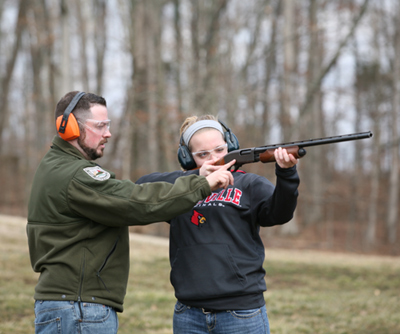BY
FRANKFORT, Ky. – It is a few minutes before 6 p.m. on Friday and vehicles continue pulling into the parking lot at the Scott County Extension Center.
An orange sign marked “Hunter Education” confirms the visitors are in the right place and directs them to proceed to the North Room, where a uniformed Kentucky Department of Fish and Wildlife Resources conservation educator welcomes his new students.
Jamie Cook asks everybody to take a registration form and a copy of the “Today’s Hunter” guide. The form will be their “passport” for the next two days, he says, and the 112-page study guide will complement the classroom instruction.

“All of you are here for different reasons,” Cook, who oversees the Hunter’s Legacy program, tells the room. “We want you to leave tomorrow afternoon safe hunters. That’s what we want to teach you.”
Hunter education courses like this are offered throughout the state and serve as an important step in the development of responsible, safe, knowledgeable and involved hunters.
Licensed hunters born on or after Jan. 1, 1975 are required to successfully complete the course. A one-year, one-time only exemption card is available for hunters unable to complete coursework by the start of a season.
More than 14,000 people took the hunter education course last year in Kentucky, according to Kentucky Fish and Wildlife Hunter Education Supervisor Bill Balda.
The desire to partake in the spring turkey season provides the motivation for many enrollees this time of year, although children wishing to participate in shooting sports offered through 4-H also take the course. Then, there are those people with no hunting tradition in their families, but an interest in starting one.
The course is offered in a classroom setting, online or on a CD. The classroom option spans 10 hours over two days. It takes a few minutes to register online at fw.ky.gov.
The classroom option is a good one for families and those new to hunting. The interaction enhances the learning process. With a Kentucky Fish and Wildlife instructor and volunteers present, students can get answers to questions immediately.
Sixty people registered for the class taught by Cook and volunteers Becky Bloomfield and Chace Wallen. Forty-seven showed up. There were fathers and sons, fathers and daughters, and entire families. A few students were alone.
The class opened with a short film portraying poor hunter behavior that led into a discussion about hunter ethics and responsibility.
The formal instruction included more videos and PowerPoint slides, but an open dialogue kept the class engaged. There are areas of emphasis, the occasional joke and subtle hints about what might appear on the next day’s exam.
Treat every firearm as if it was loaded was one phrase heard, and repeated, often.
Class broke at around 9 p.m. Friday after covering the importance of planning and preparation, hunting strategies, shot selection, survival skills, types of firearms and how to handle them safely. This session also educated attendees about the hunter’s role in wildlife conservation. It would reconvene at 8:30 a.m. Saturday and cover tree stand safety, ammunition, archery and trapping before exam time.
To earn the coveted orange hunter education card, which is valid in every state and shows you grasp the basics, a person must correctly answer at least 80 percent of the 50 questions on a written exam and participate in the “range day.”
“Do most people pass?” a young lady asked.
Cook assured that most people pass.
The test is split into true-false and multiple choice questions. All but one student earned a passing grade. After a lunch break, the class reconvened at nearby Veterans Memorial Wildlife Management Area (WMA) for the range portion. Another 37 students who completed the online or CD course offerings attended it as well.
The classroom group started at the skeet shooting station. Shooters were given their choice of a 12-gauge pump action shotgun or 20-gauge single shot, break action shotgun. Most of the kids opted for the 20-gauge while the adults chose the beefier 12-gauge.
Wallen loaded the guns for the younger shooters and everybody could take up to three shots at clay targets arcing through the air from left to right. Some stopped after one attempt. Others walked away rubbing their shoulder from the kick of the gun but happy to have had the opportunity.
Bloomfield signed students’ passports after successfully completing the exercise.
As the day wore on, camaraderie developed among the group that had taken the class together. Small talk turned into full-fledged conversations as people waited for their turn at the final two stations.
The day’s last group included two father-son pairs, a college-aged woman and a 39-year-old father of two with no previous hunting experience.
The group practiced techniques for carrying a gun in the field – in this case an unloaded air gun – were quizzed about shot selection and reviewed tree stand safety before walking back to a vacant house on the property that served as a meeting point.
Blaze orange vests were returned and passports submitted for the final time. Cook signed the papers and placed them in a cardboard box. It was around 4 p.m. and the group had successfully completed the hunter education course.
Their orange hunter education cards would be arriving within two weeks, opening the door to continuing family traditions or creating new ones in Kentucky and elsewhere.
Kevin Kelly is a writer for Kentucky Afield magazine, the official publication of the Kentucky Department of Fish and Wildlife Resources. He is an avid angler with a passion for muskellunge and stream fishing.
-30-
The Kentucky Department of Fish and Wildlife Resources manages, regulates, enforces and promotes responsible use of all fish and wildlife species, their habitats, public wildlife areas and waterways for the benefit of those resources and for public enjoyment. Kentucky Fish and Wildlife is an agency of the Tourism, Arts and Heritage Cabinet. For more information on the department, visit our website at fw.ky.gov.


Be the first to comment